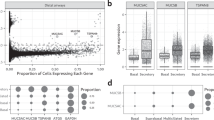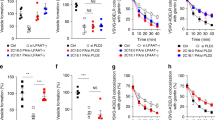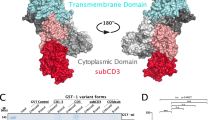Abstract
ELUCIDATION of the reactions responsible for the calcium-regulated fusion of secretory granules with the plasma membrane in secretory cells would be facilitated by the identification of participant proteins having known biochemical activities. The successful characterization of cytosolic1–3 and vesicle4,5 proteins that may function in calcium-regulated secretion has not yet revealed the molecular events underlying this process. Regulated secretion consists of sequential priming and triggering steps which depend on ATP and Ca2+, respectively, and require distinct cytosolic proteins6. Characterization of priming-specific factors (PEP proteins) should enable the ATP-requiring reactions to be identified. Here we show that one of the mammalian priming factors (PEP3) is identical to phosphatidylinositol transfer protein (PITP)7. The physiological role of PITP was previously unknown. We also find that SEC14p, the yeast phosphatidylinositol transfer protein which is essential for constitutive secretion8–10, can substitute for PEP3/PITP in priming. Our results indicate that a role for phospholipid transfer proteins is conserved in the constitutive and regulated secretory pathways.
This is a preview of subscription content, access via your institution
Access options
Subscribe to this journal
Receive 51 print issues and online access
$199.00 per year
only $3.90 per issue
Buy this article
- Purchase on Springer Link
- Instant access to full article PDF
Prices may be subject to local taxes which are calculated during checkout
Similar content being viewed by others
References
Walent, J. H., Porter, B. W. & Martin, T. F. J. Cell 70, 765–775 (1992).
Morgan, A. & Burgoyne, R. D. Nature 355, 833–836 (1992).
Wu, Y. N., Vu, N.-D. & Wagner, P. D. Biochem. J. 285, 697–700 (1992).
Söllner, T. et al. Nature 362, 318–324 (1993).
Bennett, M. K. & Scheller, R. H. Proc. natn. Acad. Sci. U.S.A. 90, 2559–2563 (1993).
Hay, J. C. & Martin, T. F. J. J. Cell Biol. 119, 139–151 (1992).
Helmkamp, G. M. Jr, Harvey, M. S., Wirtz, K. W. A. & van Deenen, L. L. M. J. biol. Chem. 249, 6382–6389 (1974).
Bankaitis, V. A., Malehorn, D. E., Emr, S. D. & Greene, R. J. Cell Biol. 108, 1271–1281 (1989).
Bankaitis, V. A., Aitken, J. R., Cleves, A. E. & Dowhan, W. Nature 347, 561–562 (1990).
Aitken, J. F., van Heusden, G. P. H., Temkin, M. & Dowhan, W. J. biol. Chem. 265, 4711–4717 (1990).
Dickeson, S. K. et al. J. biol. Chem. 264, 16557–16564 (1989).
Van Paridon, P. A., Visser, A. J. W. G. & Wirtz, K. W. A. Biochim biophys. Acta 898, 172–180 (1987).
DiCorleto, P. E., Warach, J. B. & Zilversmit, D. B. J. biol. Chem. 254, 7795–7802 (1979).
Daum, G. & Paltauf, F. Biochim. biophys. Acta 794, 385–391 (1984).
Szolderits, G., Hermetter, A., Paltauf, F. & Daum, G. Biochim. biophys. Acta 986, 301–309 (1989).
Phillips, J. H. Biochem. J. 136, 579–587 (1973).
Husebye, E. S. & Flatmark, T. Biochim. biophys. Acta 968, 261–265 (1988).
Eberhard, D. A., Cooper, C. L., Low, M. G. & Holz, R. W. Biochem. J. 268, 15–25 (1990).
Schu, P. V. et al. Science 260, 88–91 (1993).
Stack, J. H., Herman, P. K., Schu, P. V. & Emr, S. D. EMBO J. 12, 2195–2204 (1993).
Anderson, R. A. & Marchesi, V. T. Nature 318, 295–298 (1985).
Lassing, I. & Lindberg, U. Nature 314, 472–474 (1985).
Janmey, P. A. & Stossel, T. P. Nature 325, 362–364 (1987).
Fukami, K. et al. Nature 359, 150–152 (1992).
Whitters, E. A., Cleves, A. E., McGee, T. P., Skinner, H. B. & Bankaitis, V. A. J. Cell Biol. 122, 79–94 (1993).
Cleves, A. E. et al. Cell 64, 789–800 (1991).
Martin, T. F. J. Meth. Enzym. 168, 225–233 (1989).
Laemmli, U. K. Nature 227, 680–685 (1970).
Heukeshoven, J. & Dernick, R. Electrophoresis 6, 103–112 (1985).
Burnette, W. N. Analyt. Biochem. 112, 195–203 (1981).
Author information
Authors and Affiliations
Rights and permissions
About this article
Cite this article
Hay, J., Martin, T. Phosphatidylinositol transfer protein required for ATP-dependent priming of Ca2+-activated secretion. Nature 366, 572–575 (1993). https://doi.org/10.1038/366572a0
Received:
Accepted:
Issue Date:
DOI: https://doi.org/10.1038/366572a0
This article is cited by
-
Restoration of PITPNA in Type 2 diabetic human islets reverses pancreatic beta-cell dysfunction
Nature Communications (2023)
-
Insulin granule biogenesis and exocytosis
Cellular and Molecular Life Sciences (2021)
-
Phosphatidylinositol 4-Kinases and PI4P Metabolism in the Nervous System: Roles in Psychiatric and Neurological Diseases
Molecular Neurobiology (2013)
-
Membrane protein sequestering by ionic protein–lipid interactions
Nature (2011)
Comments
By submitting a comment you agree to abide by our Terms and Community Guidelines. If you find something abusive or that does not comply with our terms or guidelines please flag it as inappropriate.



